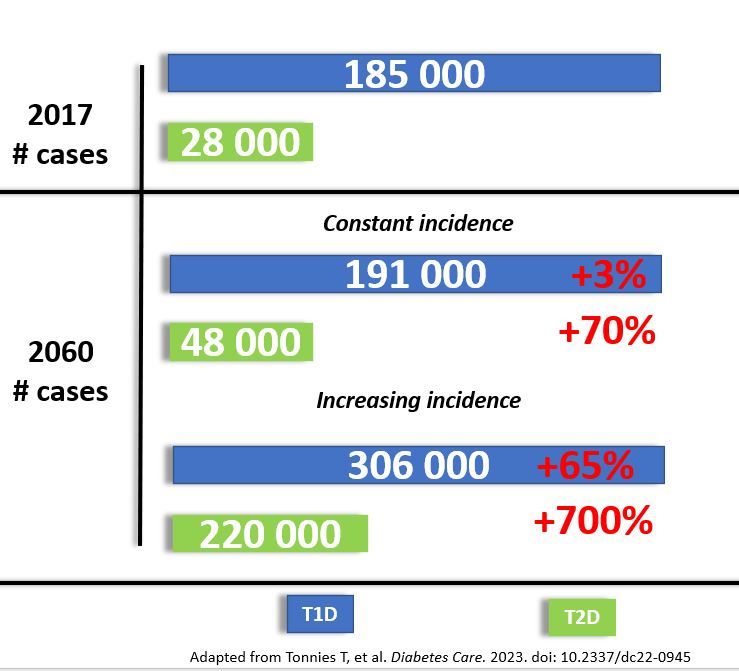- Clinical Technology
- Adult Immunization
- Hepatology
- Pediatric Immunization
- Screening
- Psychiatry
- Allergy
- Women's Health
- Cardiology
- Pediatrics
- Dermatology
- Endocrinology
- Pain Management
- Gastroenterology
- Infectious Disease
- Obesity Medicine
- Rheumatology
- Nephrology
- Neurology
- Pulmonology
Diabetes in US Youth Projected to Surge Dangerously by 2060
The number of youths in the US with both type 1 and type 2 diabetes is expected to surge dangerously over the next 4 decades, according to a new modeling study that also projects the disease burden will be greater on racial and ethnic minorities over time.
If diagnoses continue to accelerate at rates observed for calendar years 2002-2017, the study suggests, the projected number of youths aged >20 years with type 1 diabetes (T1D) would increase by 65% by 2060 and the number with type 2 diabetes (T2D) increase by >600%.
“The number of youths with diabetes is projected to increase substantially, emphasizing the importance of additional research on, and implementation of, primary and secondary preventive interventions,” wrote investigators in the journal Diabetes Care. “The projected trends indicate a substantial widening of the gap in health disparities in type 2 diabetes prevalence, with the highest estimates for [non-Hispanic Black] youth. If the current trends continue, US health care systems could face an increasing demand of youth-onset diabetes health care services, resulting in increasing health care costs.”
“The projected trends indicate a substantial widening of the gap in health disparities in type 2 diabetes prevalence, with the highest estimates for [non-Hispanic Black] youth..."
The research team, led by Giuseppina Imperatore, MD, PhD, Division of Diabetes Translation, National Center for Chronic Disease Prevention and Health Promotion, Centers for Disease Control and Prevention (CDC), Atlanta, GA, obtained data for the modeling study from the SEARCH for Diabetes in Youth study, a national, multicenter project launched in 2020 and funded by the CDC focused on the disease of diabetes itself as well as the long-term impacts on children and young adults.
FINDINGS
The SEARCH for Diabetes in Youth study included 3.6 million youth of whom 7759 had prevalent T1D and 1230 had prevalent T2D. Investigators calculated the mean annual number of incident diabetes cases observed between 2002 and 2017 for T1D to be 1100 and of T2D to be 300, according to the study.
Imperatore and colleagues projected the increase in diabetes prevalence based on 2 hypothetical scenarios: 1) if the rate of incidence observed remained constant with 2017 trends and, 2) if the trends in increased incidence observed between 2002 and 2017 persist.
Based on the first scenario, assuming incidence remains constant as observed in 2017, the overall number of youths with diabetes will increase from 213 000 in 2017 to 239 000 in 2060. Specifically, for T1D the increase would be from 185 000 to 191 000 and, for T2D, an increase from 28 000 to 48 000, corresponding to relative increases of 3% (95% CI, -9 to 21) and 69% (95% CI, 43 to 109), respectively.

In the second scenario, ie, increasing trends in incidence seen between 2002 and 2017 persist, the researchers project the total number of youths with diabetes will rise to 526 000, with 306 000 cases of T1D and 220 000 cases of T2D, increases that translate to 65% (95% CI, 12 to 158) for T1D and to 673% (95% CI, 362 to 1341) for T2D.
Investigators pointed out, for both scenarios, a substantial widening of racial and ethnic disparities in type 2 diabetes prevalence was expected, with greatest prevalence observed among non-Hispanic Black youth.
“Increases in diabetes—especially among young people—are always worrisome, but these numbers are alarming,” said Christopher Holliday, PhD, MPH, MA, director of CDC’s Division of Diabetes Translation in a CDC statement on the findings. “This study’s startling projections of type 2 diabetes increases show why it is crucial to advance health equity and reduce the widespread disparities that already take a toll on people’s health.”
The CDC implicates the alarming increase in pediatric obesity and maternal diabetes as potential contributing factors, noting both raise the risk of diabetes in young people.
“This study’s startling projections of type 2 diabetes increases show why it is crucial to advance health equity and reduce the widespread disparities that already take a toll on people’s health.”
The investigators say their projections indicate an “increasing demand for diabetes specialists and care teams to care for children, adolescents, and emerging adults; medical devices; and programs aimed at optimizing glycemic control and preventing complications in future decades.”
Reference: Tönnies T, Brinks R, Isom S, et al. Projections of type 1 and type 2 diabetes in the US population aged <20 years through 2060: the SEARCH for Diabetes in Youth study. Diabetes Care. Published online December 29, 2022. doi: 10.2337/dc22-0945
